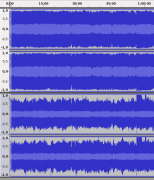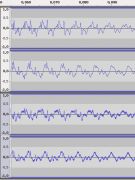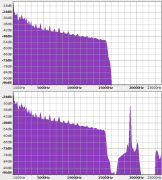Comparing analog and digital radio on the cable.
Out of curiosity I decided to compare the audio quality of a local radio station (1Live), which I can receive in analog and in digital via my local cable operator. The privately owned radios on the cable are encrypted and can only be received with the appropriate CA Module and a SmartCard for the DVB-C card. The publicly funded station are however available unencrypted.
I use these two cards to record the audio from DVB-C (the first) and for the analog broadcast (the second):
05:00.0 Multimedia controller: Philips Semiconductors SAA7146 (rev 01)
Subsystem: KNC One Device 0022
05:02.0 Multimedia video controller: Brooktree Corporation Bt878 Video Capture (rev 11)
Subsystem: Hauppauge computer works Inc. WinTV Series

This first picture compares the volume levels. The above half is from the digital broadcast and the lower half from the analog broadcast, both showing about 1 hour from the same show. Both recordings are normalized to -0.2db of maximum level with Audacity.
As you can see, the analog broadcast has a certain dynamic range left, while the digital broadcast is completely flat. Apparently, the signal, which is used to create the digital stream is passed through a compressor, which reduces the dynamic range to a minimum. Not very nice. Apparently not every station does this compressor thing. Another station from Berlin I’m occasionally listening to in digital has a lot more dynamic range left.

This next picture provides a detailed waveform view. The upper shows a very clean signal from the digital broadcast, as is to be expected. On the lower half the noise is apparent in the analog broadcast, which is overlayed on the normal signal. An analog broadcast simply can’t provide the same absolute maximum dynamic range as a the digital signal can. Another problem probably is, that the old BTTV TV-card doesn’t carry very high quality electronic components, which adds to the level of noise.

The last picture compares the frequency ranges, which each broadcast type offers. There is nothing much left above 15KHz. In the analog broadcast the peak at 19KHz is stereo pilot signal used to indicate stereo broadcasts. This is not a usable audio signal.
Our local cable operator is trying pretty aggressively to get new customers and are trying to convince the customers of the advantages of digital TV and radio. From the above pictures the digital advantage is not really visible, except maybe for the better signal-noise ratio. Additional problem is the requirement of SmartCards, if you want to listen to private radios. With the digital receiver provided by the cable operator, where you insert the SmartCard, you can either watch TV or listen to radio, not both at the same time. So, the remaining receivers in the house hold need to use the analog signal anyway. Who would spend another 5€ per month for another SmartCard?
